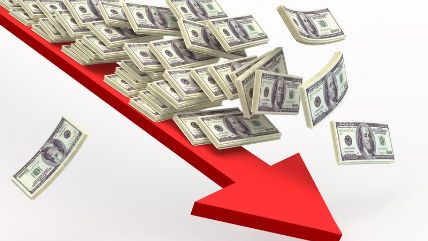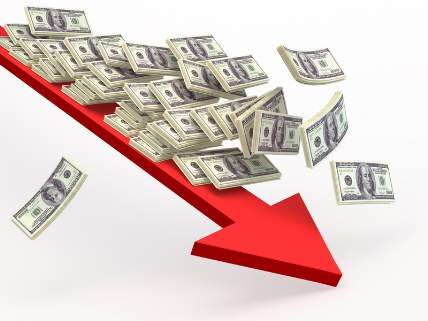Public Employee Pension Funds Prepare for Year of Crappy Returns
Don't worry-you'll make up the difference.


During the big recession, California's pension funds took a pounding, earning just one percent in returns in 2012, by way of example. That is a bit of a problem when the fund promises 7.5 percent returns over the long run to retirees. The pension fund's assets, as a whole, lost a quarter of its value during the financial crisis. Since the pensions are guaranteed, though, the plunge required municipalities and school districts to increase their contributions, thus adding even more to local government financial problems.
The funds bounced back big time last year, with the California Public Employee Retirement System's (CalPERS) returns hitting 18.4 percent. But, the Wall Street Journal notes (full article is paywalled, but can be accessed with a Google news search), the pensions are set to underperform again this year:
The $301 billion pension fund, the largest in the U.S. by assets and known as Calpers, said it earned 2.4% on its investments for the fiscal year ended June 30 because of a slump in the markets and weak private-equity returns. The performance was just shy of its internal goal of 2.5%. It was Calpers' poorest year since 2012, when it earned 1%, and down from 18.4% in 2014.
Calpers is closely watched as a bellwether for how other large pensions across the U.S. will perform, and many of them will report annual results in coming weeks. Pension investments have been challenged this year by low interest rates, uneven market performance and the recovery of the U.S. dollar, which has weakened gains in global stocks.
Many U.S. pensions, including Calpers, don't have enough assets to cover future retirement costs, so investments are critical to close that gap. In some cases, subpar investment results can dial up the pressure on states and cities to force employees to contribute more to retirement plans or cut the benefits retirees are due to receive.
One of the other reasons CalPERS underperforms is because the investment process has been highly politicized, with people calling for investment decisions based not on sound market decisions that will earn the most money, but on rewarding or punishing favored or disfavored options (such disfavored options as investing in guns and tobacco, for example). Why should they care if their social activism is bad business? The returns are guaranteed, so they'll never have to suffer negative consequences for them. Instead, the taxpayers will.
According to The Wall Street Journal, one of the best performers in the pension fund's program was the portfolio for hedge funds, earning two percentage points more than internal targets. But CalPERS announced last year they'd be dumping its hedge fund investments and shifting them to real estate and private equity assets. Their private equity investments underperformed by more than two percentage points, though.
The Wall Street Journal concludes:
A singular dip in performance won't necessarily lead to immediate cost increases for retirement systems, but it does turn up the pressure for better results in the years ahead, said Keith Brainard, research director at the National Association of State Retirement Administrators, an industry group.
"It's a marathon, not a sprint," he said. "Nobody expects stable 7.5% or 8% returns year in, year out."
Expecting that level of return at all is part of the problem though. If taxpayers weren't expected to make up the difference in returns, they could be as cautious or as socially conscientious as they wanted to be.
Editor's Note: As of February 29, 2024, commenting privileges on reason.com posts are limited to Reason Plus subscribers. Past commenters are grandfathered in for a temporary period. Subscribe here to preserve your ability to comment. Your Reason Plus subscription also gives you an ad-free version of reason.com, along with full access to the digital edition and archives of Reason magazine. We request that comments be civil and on-topic. We do not moderate or assume any responsibility for comments, which are owned by the readers who post them. Comments do not represent the views of reason.com or Reason Foundation. We reserve the right to delete any comment and ban commenters for any reason at any time. Comments may only be edited within 5 minutes of posting. Report abuses.
Please to post comments




When they come to me for payment do you know if they'll take heavy metals?
Like, lead?
So the solution is soylent green? Okay, got it, thanks.
Depends on your source of raw materials.
Use pensioners and you are working the problem from both ends.
1% return in 2012? Seriously? Simply putting their money in an S&P 500 index fund would have returned over 13%. Even ten-year T bills would have returned 2.79%. What sort of clowns run that operation?
The kind that should've been fired long, long ago...
CALPERS announces they're going broke every other year. Remember how they were a MAJOR investor in Enron? And the response of the state government is to give them more autonomy and more money. Meanwhile the man bites dog story of cops retiring on $300,000/year are becoming more and more commonplace. I say let it all implode.
If you ask any of my compatriots or any of the local and state politicians about possible issues with CalPers, they will just tell you that it is stupid editors combined with "accounting gimmicks" and that there is no problem with the public employee retirement system.
They are that willfully ignorant. I've never met one, sav for a couple of top level, finance officers, that have any grasp of the proportion and depth of the public sector retirement issues. They are sure there is a free lunch. They will tell you that the benefits are not all that lucrative.
Look at the citizen uprising in Greece when austerity is mentioned.
90%@50 pensions with health care for life = NPV$1M. Cops & firefighters retire as millionaires but have no idea they are. They just can't see the "value" in this. They can only see that they don't have $1M in the bank, so you're a liar when you tell them they are millionaires.
Just check out the comments that follow this blurb on Vallejo's failure to put pensions aside in their bankruptcy proceedings due to the club that CalPers held over their heads:
http://calpensions.com/2012/01.....sion-cuts/
That's only one example of the mentality of the public employee royalty. And, in a state like CA, they are at least equal in number to the private sector proletariat.
To quote William F. Buckley, "Idealism is fine, but as it approaches reality, the costs become prohibitive." - or the lost profits.
So no tobacco even though there was a study of the original S&P 500 that showed the best single stock to own was Philip Morris(now known as Altria). It averaged around 19.75% compounded average annual return from 1957 (the start of the S&P500;) through 2003(the end of the study). It is still chugging along in 2015 having spun off Philip Morris International and Kraft, which in turn spun off Mondelez; all of which keep going up slowly and paying out very nice dividends.
But no, these ass clowns at CALPRS would rather make a point than make a decent return on investment. But that's ok as California taxpayers will ultimately pay for their fiduciary negligence.